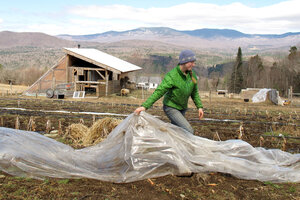Vermont, food industry begin court fight over GMO label law
A coalition of industry groups sued Vermont over the state's new law requiring food producers to put special labels on products treated with GMOs. It makes Vermont ground zero of a very big food fight.

Katie Spring rolls up plastic that was used to cover certain plants during the winter in a field at the Good Heart Farmstead in Worcester, Vt., on April 24. On May 8, Gov. Peter Shumlin signed legislation making the state the first to require labeling of genetically modified foods, a measure that Ms. Spring says she supports.
Wilson Ring/AP/File
Tiny Vermont this month boldly went where no US state had gone before, enacting a law to require food producers who treat their products with genetically modified organisms to let consumers know that on the packaging. Now, the state is going, perhaps just as boldly, to court.
A lawsuit filed Thursday challenges Vermont’s GMO-labeling law on grounds that it usurps federal regulatory authority and negatively affects interstate commerce. The new law, moreover, is arbitrary given the dearth of scientific evidence that GMOs have negative health effects, argues the coalition of industry groups that brought the federal suit, including the Snack Food Association and the Grocery Manufacturers Association (GMA).
“The proscriptions … are beyond Vermont’s power to enact,” the industry groups argue in their brief. “The State is compelling manufacturers to convey messages they do not want to convey, without anything close to a sufficient justification.”
A lot of states, including Vermont, saw this one coming. Some have also enacted GMO labeling laws, but they watered theirs down – often delaying implementation until a critical mass of states had approved requiring labels on such food products – in part to avoid getting sued.
In Connecticut, a labeling law approved in December 2013 will go into effect only after other northeastern states with a cumulative population of at least 20 million also pass such laws. In January, Maine passed a similar bill that requires five nearby states, including New Hampshire, to pass GMO labeling measures before its own law can go into effect.
“We were against these trigger clauses,” says George Kimbrell, senior attorney for the Center for Food Safety, an advocacy and research group that supports GMO labels. “But those states were afraid of getting sued by [agribusiness giant] Monsanto, the GMA, the biotech industry. The industry has done a lot of scare-mongering in Vermont, and it’s done this in other places, too.”
In Washington State, voters in 2013 rejected a ballot measure to require the labeling of food GMOs, as did California voters in 2012. Agribusiness interests spent at least $20 million on an anti-labeling campaign in Washington, and Monsanto and other firms shelled out $46 million to persuade Californians of the demerits of Proposition 37.
Likewise, threats of a costly lawsuit caused even Vermont’s legislators to table, back in 2012, GMO labeling legislation.
But now, Vermonters appear to be running toward the legal battle. Indeed, the legislature appropriated $1.5 million to administer the new regulations – which includes defending the label law in court. It also established Vermont Food Fight, an organization that collects donations from citizens and civic organizations to help fund the state’s legal battle. The labeling requirement would kick in as of July 2016.
The labeling measures could pose a definite burden for industry: About 75 percent of processed foods available on supermarket shelves in the US are genetically modified, as well as 85 percent of corn and 91 percent of soybeans.
GMO-labeling advocates in Vermont and elsewhere are unmoved. And they don't buy the claim that GMOs are harmless in food for human consumption.
“I can tell you that the GMA's assertion that the law has no basis in health, safety, or science is patently false,” writes Laurie Beyranevand, associate director of the Center for Agriculture and Food Systems at the Vermont Law School, in an e-mail. “The law recognizes that there aren't any long term independent studies that haven't been funded by industry which establish the health and safety of genetically engineered foods.”
Moreover, advocates say, the labels add transparency to the retail process, an inherent positive.
“The primary benefit is that it would give consumers information about what they’re consuming, about the kinds of foods they put on their table,” says Andrea Stander, executive director of Rural Vermont, a localvore foods network.
Not all experts agree. Some say this attempt to bolster consumer knowledge could backfire.
“Some of the labeling is very arbitrary,” says Pamela Ronald, director of the Laboratory for Crop Genetics Innovation at the University of California at Davis. “Cheese is not labeled … animals fed genetically modified food needn’t be labeled.”
Dr. Ronald claims that consumers will be misled by blanket labeling of GMOs, which in some cases have positive environmental impacts. She cites the use of BT bacterium on corn, which can reduce pesticide use tenfold.
In Congress, lawmakers are staking out their respective turf on the issue. On April 10, Reps. Mike Pompeo (R) of Kansas and G.K. Butterfield (D) of North Carolina introduced the Safe and Accurate Food Labeling Act of 2014, which would give the US Food and Drug Administration sole authority over GMO food labels.
Sen. Barbara Boxer (D) of California and Rep. Peter DeFazio (D) of Oregon, meanwhile, last year introduced essentially the opposite bill: the Genetically Engineered Foods Right-to-Know Act, which would mandate GMO labeling nationwide.
Neither measure is likely to pass, however. That leaves Vermont as the central battleground in the GMO fight, at least for the foreseeable future.

